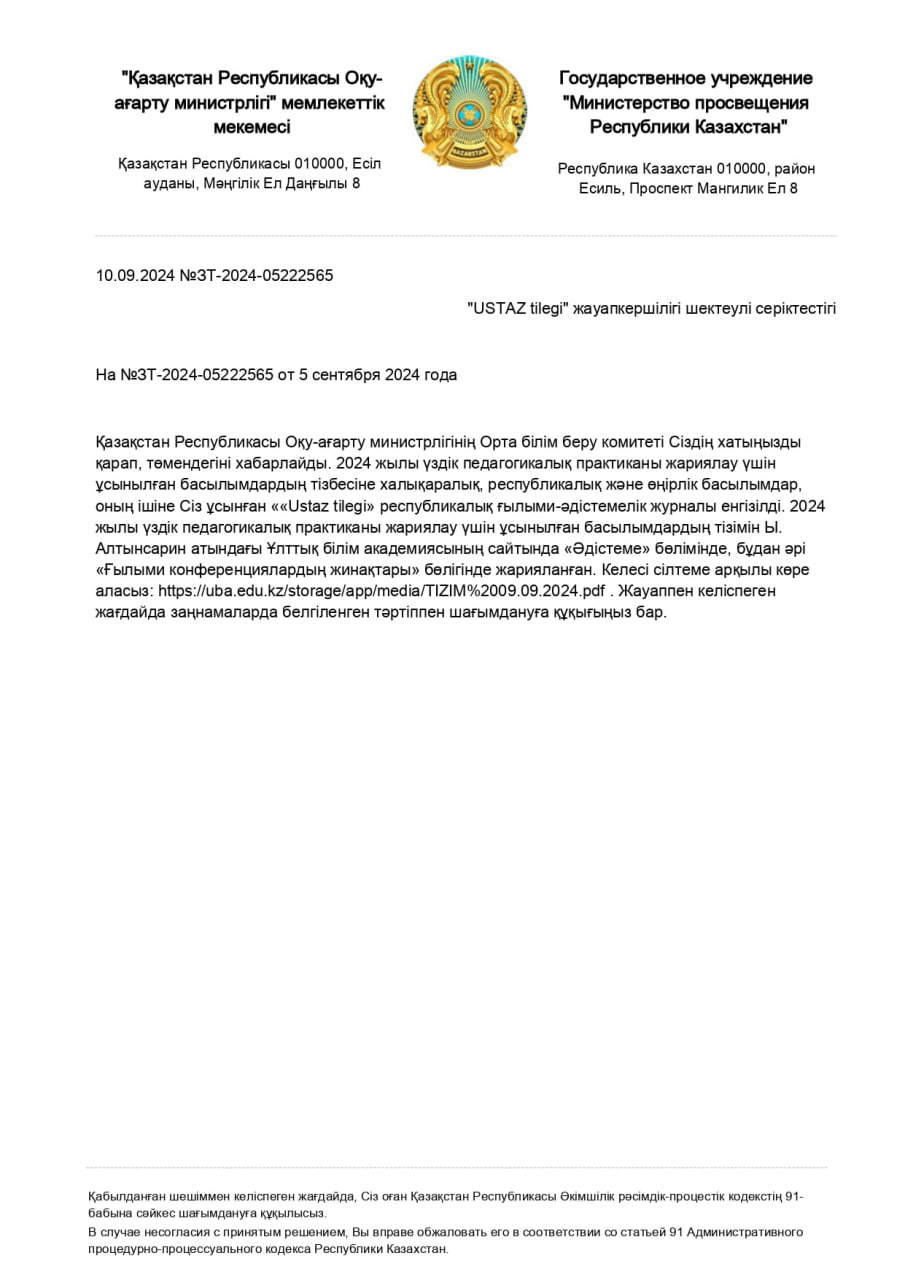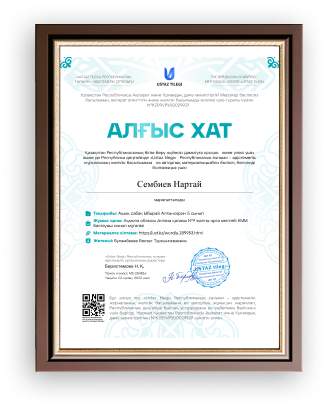
Мәжитова А.Қ
5B011900 «Шетел тілі: екі шетел тілі» мамандығының 3 курс студенті, Қ.Жұбанов атындағы Ақтөбе өңірлік мемлекеттік университеті, Ақтөбе, Қазақстан
Distance learning, also called distance education, e-learning, and online learning, form of education in which the main elements include physical separation of teachers and students during instruction and the use of various technologies to facilitate student-teacher and student-student communication. Distance learning traditionally has focused on nontraditional students, such as full-time workers, military personnel, and nonresidents or individuals in remote regions who are unable to attend classroom lectures. However, distance learning has become an established part of the educational world, with trends pointing to ongoing growth. In U.S. higher education alone, more than 5.6 million university students were enrolled in at least one online course in the autumn of 2009, up from 1.6 million in 2002. An increasing number of universities provide distance learning opportunities. A pioneer in the field is the University of Phoenix, which was founded in Arizona in 1976 and by the first decade of the 21st century had become the largest private school in the world, with more than 400,000 enrolled students. It was one of the earliest adopters of distance learning technology, although many of its students spend some time in classrooms on one of its dozens of campuses in the United States, Canada, and Puerto Rico. A precise figure for the international enrollment in distance learning is unavailable, but the enrollment at two of the largest public universities that heavily utilize distance learning methods gives some indication: in the early 21st century the Indira Gandhi National Open University, headquartered in New Delhi, had an enrollment in excess of 1.5 million students, and the China Central Radio and TV University, headquartered in Beijing, had more than 500,000 students. Students and institutions embrace distance learning with good reason. Universities benefit by adding students without having to construct classrooms and housing, and students reap the advantages of being able to work where and when they choose. Public-school systems offer specialty courses such as small-enrollment languages and Advanced Placement classes without having to set up multiple classrooms. In addition, homeschooled students gain access to centralized instruction.
Various terms have been used to describe the phenomenon of distance learning. Strictly speaking, distance learning (the student’s activity) and distance teaching (the teacher’s activity) together make up distance education. Common variations include e-learning or online learning, used when the Internet is the medium; virtual learning, which usually refers to courses taken outside a classroom by primary- or secondary-school pupils (and also typically using the Internet); correspondence education, the long-standing method in which individual instruction is conducted by mail; and open learning, the system common in Europe for learning through the “open” university. Four characteristics distinguish distance learning. First, distance learning is by definition carried out through institutions; it is not self-study or a nonacademic learning environment. The institutions may or may not offer traditional classroom-based instruction as well, but they are eligible for accreditation by the same agencies as those employing traditional methods. Second, geographic separation is inherent in distance learning, and time may also separate students and teachers. Accessibility and convenience are important advantages of this mode of education. Well-designed programs can also bridge intellectual, cultural, and social differences between students. Third, interactive telecommunications connect individuals within a learning group and with the teacher. Most often, electronic communications, such as e-mail, are used, but traditional forms of communication, such as the postal system, may also play a role. Whatever the medium, interaction is essential to distance education, as it is to any education. The connections of learners, teachers, and instructional resources become less dependent on physical proximity as communications systems become more sophisticated and widely available; consequently, the Internet, mobile phones, and e-mail have contributed to the rapid growth in distance learning.
Finally, distance education, like any education, establishes a learning group, sometimes called a learning community, which is composed of students, a teacher, and instructional resources—i.e., the books, audio, video, and graphic displays that allow the student to access the content of instruction. Social networking on the Internet promotes the idea of community building. On sites such as Facebook and YouTube, users construct profiles, identify members (“friends”) with whom they share a connection, and build new communities of like-minded persons. In the distance learning setting, such networking can enable students’ connections with each other and thereby reduce their sense of isolation.
Пайдаланған әдебиеттер тізімі
-
Using video in distance learning. For teachers and teachers. Second edition. Boris Ivanovich Kruk.
-
Models of the training course in the development of distance learning systems A.S Dorofeev Programs Applied Informatics. Scientific articles 2007
-
e-learning: How to make e-learning clear, quality and affordable. Michael Allen Foreign educational literature None 2006
-
Selected chapters of distance learning theory and practice B.I.Kruk Other educational literature
жүктеу мүмкіндігіне ие боласыз
Бұл материал сайт қолданушысы жариялаған. Материалдың ішінде жазылған барлық ақпаратқа жауапкершілікті жариялаған қолданушы жауап береді. Ұстаз тілегі тек ақпаратты таратуға қолдау көрсетеді. Егер материал сіздің авторлық құқығыңызды бұзған болса немесе басқа да себептермен сайттан өшіру керек деп ойласаңыз осында жазыңыз
Distance learning
Distance learning
Мәжитова А.Қ
5B011900 «Шетел тілі: екі шетел тілі» мамандығының 3 курс студенті, Қ.Жұбанов атындағы Ақтөбе өңірлік мемлекеттік университеті, Ақтөбе, Қазақстан
Distance learning, also called distance education, e-learning, and online learning, form of education in which the main elements include physical separation of teachers and students during instruction and the use of various technologies to facilitate student-teacher and student-student communication. Distance learning traditionally has focused on nontraditional students, such as full-time workers, military personnel, and nonresidents or individuals in remote regions who are unable to attend classroom lectures. However, distance learning has become an established part of the educational world, with trends pointing to ongoing growth. In U.S. higher education alone, more than 5.6 million university students were enrolled in at least one online course in the autumn of 2009, up from 1.6 million in 2002. An increasing number of universities provide distance learning opportunities. A pioneer in the field is the University of Phoenix, which was founded in Arizona in 1976 and by the first decade of the 21st century had become the largest private school in the world, with more than 400,000 enrolled students. It was one of the earliest adopters of distance learning technology, although many of its students spend some time in classrooms on one of its dozens of campuses in the United States, Canada, and Puerto Rico. A precise figure for the international enrollment in distance learning is unavailable, but the enrollment at two of the largest public universities that heavily utilize distance learning methods gives some indication: in the early 21st century the Indira Gandhi National Open University, headquartered in New Delhi, had an enrollment in excess of 1.5 million students, and the China Central Radio and TV University, headquartered in Beijing, had more than 500,000 students. Students and institutions embrace distance learning with good reason. Universities benefit by adding students without having to construct classrooms and housing, and students reap the advantages of being able to work where and when they choose. Public-school systems offer specialty courses such as small-enrollment languages and Advanced Placement classes without having to set up multiple classrooms. In addition, homeschooled students gain access to centralized instruction.
Various terms have been used to describe the phenomenon of distance learning. Strictly speaking, distance learning (the student’s activity) and distance teaching (the teacher’s activity) together make up distance education. Common variations include e-learning or online learning, used when the Internet is the medium; virtual learning, which usually refers to courses taken outside a classroom by primary- or secondary-school pupils (and also typically using the Internet); correspondence education, the long-standing method in which individual instruction is conducted by mail; and open learning, the system common in Europe for learning through the “open” university. Four characteristics distinguish distance learning. First, distance learning is by definition carried out through institutions; it is not self-study or a nonacademic learning environment. The institutions may or may not offer traditional classroom-based instruction as well, but they are eligible for accreditation by the same agencies as those employing traditional methods. Second, geographic separation is inherent in distance learning, and time may also separate students and teachers. Accessibility and convenience are important advantages of this mode of education. Well-designed programs can also bridge intellectual, cultural, and social differences between students. Third, interactive telecommunications connect individuals within a learning group and with the teacher. Most often, electronic communications, such as e-mail, are used, but traditional forms of communication, such as the postal system, may also play a role. Whatever the medium, interaction is essential to distance education, as it is to any education. The connections of learners, teachers, and instructional resources become less dependent on physical proximity as communications systems become more sophisticated and widely available; consequently, the Internet, mobile phones, and e-mail have contributed to the rapid growth in distance learning.
Finally, distance education, like any education, establishes a learning group, sometimes called a learning community, which is composed of students, a teacher, and instructional resources—i.e., the books, audio, video, and graphic displays that allow the student to access the content of instruction. Social networking on the Internet promotes the idea of community building. On sites such as Facebook and YouTube, users construct profiles, identify members (“friends”) with whom they share a connection, and build new communities of like-minded persons. In the distance learning setting, such networking can enable students’ connections with each other and thereby reduce their sense of isolation.
Пайдаланған әдебиеттер тізімі
-
Using video in distance learning. For teachers and teachers. Second edition. Boris Ivanovich Kruk.
-
Models of the training course in the development of distance learning systems A.S Dorofeev Programs Applied Informatics. Scientific articles 2007
-
e-learning: How to make e-learning clear, quality and affordable. Michael Allen Foreign educational literature None 2006
-
Selected chapters of distance learning theory and practice B.I.Kruk Other educational literature

шағым қалдыра аласыз















